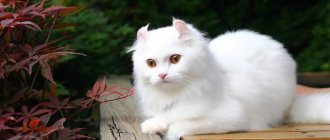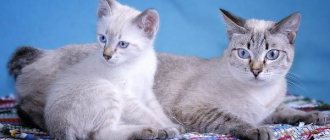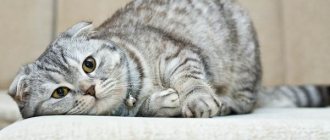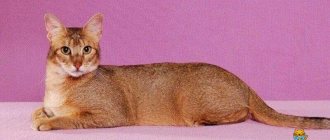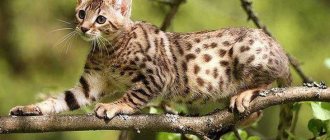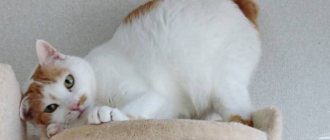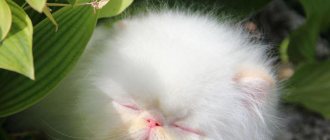History of the Serengeti breed
The serval wild cat lives in Africa, which has been attracting cat lovers for many years with its unusual appearance. This animal is the closest relative of lynxes and caracals, but is more similar to a cheetah. Servals are tamed and kept as pets, but with great restrictions, since they remain predators even in a human home.
Serval is a bush cat from Africa that looks like a small cheetah.
Breeders dream of a cat similar to a serval, but more friendly and flexible towards humans. The most famous way - crossing wild animals with domestic ones - was tested several years ago, resulting in the Savannah breed. These cats are expensive and beautiful, but there are too many problems in breeding them. The first generation of male hybrids is mostly sterile, and without the infusion of wild serval blood, after several generations the cats lose their resemblance to predators.
The Savannah breed was developed by crossing Servals with domestic cats.
American breeder Karen Sauzman found another way out. She decided to breed a domestic cat similar to the serval, using not predators, but already existing purebred cats. In this case, the phenotype (appearance) of the serval should serve as a guide, especially such features as the length of the paws, the size of the ears, coat color and much more. For this, from her point of view, the Bengal and Oriental Shorthair breeds were suitable. Bengals were expected to have solid weight and bright colors, while Oriental Shorthairs were expected to share their long legs, large ears, and overall delicacy. The spotted color of both cats also came in handy. In subsequent generations, Maine Coon and Abyssinian breeds were also used. In 1994, the first Serengeti were born. The word Serengeti itself refers to a protected area in Tanzania where servals and many other wild animals live. This is the name Karen took for her new breed.
Serengeti is a savannah national park in Tanzania, home to a huge number of African animals.
Serengeti cats turned out to be really similar to servals, without having wild serval blood. The breed is quite young, considered experimental, and has official status only in the international association TICA. However, she cannot take part in exhibitions, because, according to the requirements of felinological organizations, at least 50 nurseries must be organized for this, and so far there are much fewer of them. Work on the Serengeti is still ongoing, crossing with other breeds is allowed.
Video: origins of the Serengeti
Colors
This breed can have several types of colors:
- It can be a black spotted tabby (has contrasting black spots).
- Black, smoky or with shades of gray (has ghost mottledness).
Despite the color, the spots are always the same; they should have a round shape, slightly elongated only in a horizontal position. The presence of a dark path that comes from the inner corners of the eyes is very much appreciated.
But with all the advantages, there is, unfortunately, a drawback in their coloring - these are ordinary white, red, and spotted cats. However, in ordinary spotted cats, the spots are elongated in a vertical direction, which is not typical for representatives of the Serengeti.
Description of the Serengeti breed
The Serengeti is a serval-like cat with a muscular body on very high legs, a long neck and large ears. Silky wool most often has a spotted color. The average weight of cats is from 8 to 10 kg, cats can reach 15 kg. These animals have an excellent temperament: confident and inexcitable, yet gentle and affectionate.
Appearance
The Serengeti has an elongated head, evenly expanding from the nose to the base of the ears (modified wedge). Cheekbones and cheeks are practically not prominent; the profile is a straight line from the nose to the eyebrows. The chin is strong, but clearly defined, the nose is moderately wide, often with a black edging. The neck is long, rather thick, expanding from the head to the body.
The ears deserve special attention: they are very large, almost as long as the muzzle, set vertically, set high on the back of the head close to each other. The ears are wide and deep at the base, with rounded tips.
Ideally, the height of the Serengeti's ear should be equal to the height of the head
The eyes are large, round in shape, the distance between them is slightly greater than the size of one eye. The preferred color is golden or yellow, light green or hazel is acceptable.
The strong, long body of the Serengeti has a straight back and hips with shoulders of approximately the same width. The legs are very high, strong and muscular, with medium-sized oval-shaped paws. The tail can vary in length from medium to short, but the preferred size is up to the animal's shoulder. The shape of the tail is wide at the base, tapering towards the end, the tip is always black.
The Serengeti holds the record for the longest paws among domestic cats.
The coat of representatives of this breed is short and thick, shiny, silky, slightly shimmering, with well-defined guard hairs. The color is spotted, brown, silver-gray, black, the tail is striped. The spots are contrasting, monochromatic, and randomly located. The chin and lower abdomen are light, and the outer side of the ears has a characteristic fingerprint pattern.
The official names of the recognized colors of the Serengeti are black smoke with spots, black tabby, brown tabby, silver tabby.
Character
Unlike the predatory servals, the Serengeti has a friendly and sociable character. They love their owners and are very persistent in communication. A pet that misses affection will follow a person everywhere and demand attention: butt, get in the way, lie down on the computer keyboard and put its head under the owner’s arm. These cats have difficulty withstanding loneliness, and if treated poorly can become aggressive and irritable. Serengeti have good intelligence, they are very inventive and stubborn, and if they have something in mind, it will be very difficult to distract them from these plans. There is no need to pamper them too much with your attention, because in this regard the Serengeti is insatiable and, having become accustomed to good things, will demand manifestations of love from the owner 24 hours a day.
The Serengeti has an inquisitive and active dog-like personality and easily learns commands and tricks.
Serengeti have pronounced leadership traits and get along with other pets only if they recognize them as the main one. They will fight for the first roles until the bitter end, because they are very persistent. Courage is in their blood; the Serengeti will not run away from a dog or other cats, but will definitely fight. If the owner, in their opinion, is in danger, then the pet will protect him like a dog.
Serengetis are very active, they love to play and hunt, jump and climb, and can deliberately knock small objects onto the floor with their paws. It's part of their game. Therefore, it is recommended to put all valuables that could break if dropped into closed cabinets. The house where the Serengeti lives should be equipped with cat ladders, complexes, scratching posts and toys, then the furniture and household items will remain in order.
The house should have special structures for cats to climb and jump on, as well as scratching posts and shelters for sleeping.
Cats of this breed are very talkative. They can make many different sounds, both similar to meowing and completely different from it. They can growl, purr, yelp, coo and smack, and not just like that, but commenting on what is happening or communicating with the owner. Serengeti love to follow a person around the house and explain something to him in their language.
One of the well-known character traits of the Serengeti is talkativeness, and their language is very rich and varied.
Favorable living conditions
The best place to live in the Serengeti is a private house or cottage with a spacious plot. The energy and activity of cats of this breed requires free space, and in the yard you can hunt rodents, birds, or at least insects. Serengetis almost never get lost, even if they leave the yard, because they have excellent orientation and are not prone to wandering. They are attached to the house and their owners and will definitely return, but they can bring with them other cats and cats that they meet on free walks.
Representatives of this breed, like all cats, love to climb trees and hunt birds.
If the Serengeti lives in a city apartment, then it is advisable to sometimes take them out for walks on a leash. They get used to a leash quickly, are not afraid of street noise, and tolerate travel and various events well, so you can take the Serengeti with you to a picnic or outdoor party, the beach, or the country house. Going out into nature, even on a leash, will brighten up the urban existence of pets in the limited space of an apartment.
Serengetis get used to a harness and leash well and quickly, but it is better to accustom them to this from childhood
Character
Serengeti have a strong charisma. They are sociable, friendly, intelligent, and loyal to their owner.
According to the owners, these cats can jump up to two meters in height and constantly make not only meows, but also sounds reminiscent of chirping and purring. That's why this breed is nicknamed the talkative one.
- Animal cremation.
What are the benefits of grooming animals?
Ultrasound of animals. Why is it made?
Even in infancy, the Serengeti kitten becomes very attached to its owner and does not leave his side. To attract attention, he caresses, jumps into your arms, and looks into your face.
The Serengeti are stubborn and fearless. If these cats like something, it will be very difficult to take it away. The pet will not rest until it receives the desired item. And a fighting character will never allow you to give up.
Regardless of the weight categories and the outcome of the battle, the leader of the Serengeti will bravely rush into battle.
Buying a Serengeti kitten
The Serengeti is a rare and small breed that is in the process of improvement and is considered experimental. Therefore, it is not surprising that the best place to buy good representatives of this breed is in America, where it originated. Then, transportation costs will also be added to the considerable cost of the kitten itself. The American nursery of the ancestor of the breed, Karen Southman, has the best reputation; it is there that you can buy the best representatives.
There are no Serengeti nurseries in our country, but there are others that keep a couple or two of these cats, as well as private breeders. Serengeti can be bred with Bengals and Oriental cats. It is easier to purchase kittens from such unions and they are cheaper. The later in time a kitten is born from crossing with another breed, the more expensive it is. The most expensive are kittens of the fourth generation from outcross (that’s what crossing with another breed is called), they are considered purebred.
In Russia it is much more difficult to acquire a purebred Serengeti than in America
Prices for Serengeti kittens in our country start from 40,000 rubles and can reach up to 150,000 rubles. The cost depends on the purpose of acquisition, color and origin.
Criterias of choice
You can initially choose a kitten using photographs and videos that nurseries or breeders can provide. But the final decision must be made after meeting the kittens in person. Breeders note that often future owners come for one baby and leave with another, which they liked better. You need to see if the kitten looks healthy: it should have clean ears, eyes and thick fur without bald spots. It is also necessary to evaluate its activity: a normal cub moves a lot and plays willingly, pesters its brothers and sisters, is not afraid of people, and eats well.
Kittens from the same Serengeti litter can have different colors
When choosing a kitten, you can compare its appearance with the breed standard, but you need to keep in mind that a lot can still change with age. Pay attention to the shape of the muzzle, the size of the ears and the length of the paws, as well as the correct coloring of the cub. However, everything is relative, since a kitten that differs from the standard in some aspect of its appearance can be extremely attractive, and its cost will be low. Therefore, any baby from the litter you like is suitable as a pet. With breeding, everything is much more complicated; there are many nuances that can be discussed with professional breeders. Most likely, they will keep the best kittens for themselves.
Age of kitten to move to a new home
The ideal age for a kitten to move to a new home is three and a half months. At this age, he undergoes his first vaccination, is litter box trained and knows how to feed himself. However, kittens of this breed are quite large, have good immunity and develop quickly, so sometimes breeders allow you to pick up the babies early. Especially if there are no other animals in the house from which you can catch the disease. Then the owner himself carries out the revaccination.
Usually kittens move to a new home at the age of 3-4 months - it is at this time that they become quite mature physically and psychologically
Here I can share my personal experience of early moving a kitten into your home. Our kitten, however, was a Bengal breed, not a Serengeti, but these breeds are very close. We wanted a small cute kitten, not a 3-4 month old teenager. We are me and my daughter, who was in first grade then. Even during the selection process, I was looking for options where kittens were given away early and I came across a pattern: nurseries had strict rules in this regard, kittens could leave them only at a certain age, after vaccinations, sometimes already neutered. Therefore, I had to look for private breeders, who were more loyal in this regard. At first we wanted to buy a kitten from Belarus, we corresponded with the owner for a long time, looked at his photographs, but then we were afraid of getting a “pig in a poke.” After all, delivery had to be paid additionally and quite decently, and having received the kitten in our hands, we could not do anything if we didn’t like it. Don't send the baby back to Belarus. I had to choose a pet closer to home. I found a private breeder who had one and a half month old kittens “ready to go to a new home.” There were 5 kittens, but by the time we got to the suburbs of St. Petersburg to meet them in person, there were only 2 kittens left - our Leo and his little sister. We chose Leo, although there was little choice - after all, we wanted a boy. It was very interesting to see the kittens in their habitat: how they played with each other, splashed in a bowl of water, and also to meet their mother, whose fur shimmered bright gold in the sun. We took the boy along with his documents, and he could be registered immediately as a pet or as a cat for breeding, the price was exactly 2 times different (a cat for breeding cost twice as much). I chose and paid for a contract for a pet with the condition of mandatory castration, took the kitten’s card, listened to instructions on vaccinations and nutrition, and they also gave us a substantial portion of food that the kittens and their mother ate. It was a holistic food for kittens and pregnant cats. They put the baby in a carrier and took him home. At that time, he had only received the first vaccination, by the way, quite early. It is recommended to do it from 8 weeks, but the breeders apparently carried it out a week earlier. In the first two or three days the baby was not very comfortable, but he quickly adapted. He got used to the litter box instantly, slept with people in bed, ate well and played all the time. At 3 months, we called the veterinarian to the house, and he carried out a revaccination. Everything went well, although there could have been allergic reactions to the vaccine and fever, but this did not happen to us. At the age of 1 year, we carried out another revaccination, and two months earlier, a castration operation at home. They always called the same veterinarian (a girl) from a clinic that specialized in home visits. The quality of services was excellent, we had no complaints, and the prices were also quite reasonable. The main advantage is that the animal remains in the house and does not receive psychological trauma from sitting in lines at the veterinary clinic, where there are many other animals. In addition, before vaccination, you can easily become infected with some disease there. Therefore, I can confidently recommend in-home veterinary services, including kitten vaccinations. It was very convenient.
Other nuances
Before purchasing a kitten, you need to think again whether you are ready to keep such an active and attention-demanding creature as the Serengeti in a city apartment. Adult cats are energetic and loving, and in a kitten these qualities are even more pronounced. It’s a good idea to assess in advance the dimensions of the room where the large cat will live, to see if it’s too crowded. The best option is your own cottage with a plot of land or a spacious city apartment and periodic walks with your pet on a leash.
Serengeti cats feel best in a private house or cottage with its own plot of land, where the animal can walk and hunt to its heart’s content.
The kitten's move to a new home must be organized in advance: take it with you from the nursery or purchase things that are familiar to it, such as toys, beds, a tray, and also find out what the breeders fed it and buy the same food for the first time. Then the baby’s adaptation to the new habitat will happen quickly and painlessly. And of course, you should try to be at home most of the time while the kitten gets used to the apartment and its inhabitants, because the baby feels confused and cut off from home and family. The owner replaces his mother, sisters and brothers. In addition, due to its irrepressible curiosity and desire to touch many things with its paw and throw them on the floor, the kitten can harm itself and its owner. All dangerous and fragile objects must be removed away.
Contents of the Serengeti
The Serengeti is unpretentious, and caring for them consists of the usual procedures: combing, cleaning ears and eyes, timely deworming and vaccination. As for nutrition, this issue must be approached seriously, since the health of purebred cats is determined to a large extent by their heredity and diet.
Nutrition
When choosing a diet for the Serengeti, you need to decide whether it will be fed with natural products or prepared food. Veterinarians and breeders consider super-premium and holistic food to be the best option, because they save the owner’s time and effort, and the content of nutrients and vitamins in high-quality food is higher than in natural food.
Ready-made professional food will provide adequate nutrition for the pet and save time on preparing food for the owner
If you are still planning a diet based on natural products, then it should be developed with the participation of nutritionists for animals and contain not only meat, but also other products, and you will have to cook for your pet separately. Food must be fresh and of high quality. Salt, sugar, spices and other food additives, as well as fried and smoked foods, are not allowed in the diet. Under no circumstances should you offer your cat flour products and fish, as this provokes the development of urolithiasis.
Quantity and composition of food
When feeding natural products, 60% of the Serengeti diet should be meat, and only beef or veal. You also need to give cats poultry (chicken, turkey), cereals, vegetables, dairy products and eggs. The meat should be boiled and lean, so pork is excluded. It is definitely worth supplementing the diet with vitamin and mineral complexes for cats that can compensate for the lack of nutrients in food. A veterinarian will help you choose a vitamin preparation. When eating natural foods, tartar or other problems in the oral cavity may appear. For prevention, you can sometimes let your pet chew dry food or cartilage. Bones should not be offered, it is harmful to the health of the Serengeti.
It is imperative to include vitamin supplements for cats in their natural diet, since it is very difficult to get everything they need for health from regular food.
Most breeders feed the Serengeti with high-quality ready-made food, both dry and wet. It is better if it is premium or super premium food for large active cats. Representatives of this breed have a valuable quality: they are not prone to overeating and obesity. Therefore, dry food can be left freely available, the pet will eat as much as it needs. If your Serengeti differs from its relatives in having a more excessive appetite, then food should be given in doses. The approximate amount per feeding is indicated on the pack depending on the weight of the animal.
How many times a day should you feed your pet?
Adult animals are fed twice a day, morning and evening. Pregnant and lactating cats and kittens should eat more often - 3-4 times a day, with special food with a higher calorie content.
Your pet should always have free access to fresh, clean water. When feeding dry food, the animal needs to drink a lot, this is a factor in preventing the formation of kidney stones.
If your cat prefers to drink tap water, it is better to equip it with a filter so that the water is clean and healthy.
It is very useful to provide your cat with fresh grass, whether you grow it yourself or buy it from a pet store. Animals need grass as a vitamin supplement and for good digestion. This way, indoor plants will be protected from attacks.
The role of a balanced diet in cat health
Proper nutrition is important for the Serengeti as these animals are prone to urolithiasis. Foods containing salt, sugar, and harmful food additives can trigger an attack. Low-quality dry food can also lead to numerous diseases. Therefore, the diet should be thoughtful and balanced, agreed upon with a veterinarian or an experienced breeder. It must be borne in mind that there are special foods for animals already suffering from kidney or bladder diseases, or diets with a preventive effect. It is to them that the animal should be transferred in the event of the appearance of specific chronic diseases.
Many well-known food manufacturers have special product lines for animals suffering from certain diseases.
Video: how to choose quality cat food
Appearance care
Serengeti cats do not require complex care; they are very clean and take good care of themselves. You need to regularly examine your pet and clean its eyes and ears if necessary, and at least sometimes take your pet to the veterinarian for examination.
Brushing and bathing
The Serengeti has short and thick hair that does not form tangles, so it is not necessary to comb your pet with a comb. But regular massage with a silicone or rubber brush will remove excess hair and activate blood circulation. It is enough to carry it out once every 10–14 days; it is better to get used to this procedure from childhood.
The Serengeti does not need regular bathing, but if he often walks outside or just gets his fur dirty, he can be washed with a special shampoo for short-haired cats. Most likely, the pet will not mind, since among its ancestors there are breeds that love water and even know how to swim.
Other beauty tips
To solve the problem with claws, it is enough to get a scratching post, then the cat will independently grind them down to a comfortable size. If you need to shorten your pet's claws, you should teach him to obey from childhood, because not all cats have a positive attitude towards this procedure. The claws must be carefully trimmed with a quality nail clipper.
The main thing when trimming claws is not to damage the blood vessel running in the middle of the claw.
The eyes and ears should be periodically examined and wiped with a cotton swab containing boric acid or special products recommended by a veterinarian. The Serengeti is not prone to diseases of these organs, so problems usually do not arise with them.
It is important not to forget about regular deworming and vaccination of the animal, especially if the cat walks outside. You also need to promptly treat your pet’s fur against fleas and ticks with special products.
It is advisable to brush your pet's teeth if he eats soft food, since the formation of tartar is very likely. You can buy him special high-quality treats for cleaning his teeth or toys designed for this purpose. Teeth cleaning with a special brush and toothpaste can be carried out by the owner of the animal, and tartar removal can only be done by a specialist in a veterinary clinic. Animals that eat dry food usually do not need to have their teeth brushed.
Health
Despite their impressive size, representatives of the breed live only 10–12 years. It is unknown what causes such a low life expectancy, especially since their health is truly excellent. The only thing that is observed is a predisposition to urolithiasis (most often found in cats). The disease occurs due to a deficiency of vitamin A in the body, digestive pathology, unbalanced nutrition, hormonal disorders, complications after colds.
Characteristic symptoms:
- the stomach increases in volume;
- the animal becomes restless, constantly meows, tries to attract attention to itself;
- often licks the reproductive organs;
- goes to the toilet in the wrong places, often right in front of the owner;
- there is a frequent urge to urinate, but the pet cannot relieve itself;
- Blood clots appear in the urine.
If such symptoms occur, you should urgently go to a veterinary clinic, since it is impossible to cure the animal on your own. Treatment includes a whole range of procedures, sometimes surgery cannot be avoided. If medical care is not provided in a timely manner, death is possible (especially in pets aged 1–5 years).
Disadvantages of the Serengeti breed
The Serengeti has good heredity and good health. Such cats live for 13–15 years and with conscientious care there are practically no problems with them. The Serengeti is quite active and does not need to be forced to move and play. On the contrary, they themselves will encourage the people around them to have an energetic pastime. Serengeti have a moderate appetite and are not prone to obesity, which helps maintain health for many years.
Tendency to diseases
Like any other cat, the Serengeti can get sick from anything. This depends on the timeliness of vaccination and deworming, heredity, lifestyle, nutrition and many other factors. But in general, representatives of this breed rarely get sick.
The Serengeti has a hereditary tendency to diseases of the genitourinary system and the formation of stones. Cats are more likely to suffer from this disease than cats. Symptoms include drops of blood in the urine and difficulty urinating. In this case, you need to consult a doctor as soon as possible.
A tense posture when urinating and animal complaints are common symptoms of urolithiasis.
It is unacceptable to self-medicate. Now medicine is quite capable of coping with this disease with timely treatment and strict adherence to recommendations. The veterinarian will also help you choose a special diet for such cases.
Defects in appearance
It should be noted that work on the Serengeti breed continues and its standards have not yet been recognized by all felinological organizations. Therefore, Serengetis often differ in appearance from each other and from their breed standard.
Common disadvantages are:
- rosette-shaped spots (two-color);
- spots turning into stripes on the sides;
- heavy bones;
- squat body;
- small ears;
- short legs.
A small light medallion on the chest or a small spot in the groin area is allowed. But a white tip of the tail, white toes on the paws or splashes of white on the body, as well as blue eyes will lead to denial of the title.
A small light-colored medallion on the chest of the Serengeti is allowed, but in no case should there be white socks on the paws
Too small an animal's body size will result in disqualification. The Serengeti was meant to be big cats, and that's how they should be.
Catering
A balanced diet is the key to your pet’s health and good mood. Therefore, decide as quickly as possible what you will feed him: industrial feed or natural food?
It is not recommended to combine one with the other, just as it is not recommended to jump alternately to one or the other.
Natural products
Natural food must be of high quality and fresh, prepared according to the recommendations of veterinarians. The menu should include the following products:
- Meat: veal, beef, rabbit, lamb, poultry (chicken, quail, turkey). It is given raw (after freezing) or boiled (the latter option is worse, since cooking destroys a number of vitamins).
- Porridge: rice, oatmeal, pearl barley, millet, buckwheat, semolina. The porridge is cooked in water (only semolina for babies - in milk), without adding anything other than half a teaspoon of vegetable oil (olive, sunflower, flaxseed).
- Dairy products: yogurt, fermented baked milk, sour cream, low-fat cottage cheese, bio-yogurt.
- Vegetables: zucchini, carrots, pumpkin, asparagus, broccoli. Allows greens: green salad, dill, parsley. Vegetables can be given raw, but most often cats turn their nose up at raw ones. Therefore, stew them or boil them, chop them finely and mix with porridge and meat, add to meatballs and cutlets.
- As a treat, cats can be given a cucumber, apple, pear, watermelon or melon to chew on.
It is better not to give fish to cats of the Serengeti breed: due to kidney problems in representatives of this breed.
Your cat should always have clean water in a separate bowl. You cannot give your animal liquid from the tap: tap water can be too hard or saturated with chlorine, and contains an admixture of salts and other components that are dangerous for cats. Leave the water in a container without a lid for 10-12 hours, buy purified water in a store or pass it through a household filter.
Recommended food
If you choose ready-made food, remember: you should only buy food from the holistic and super-premium classes. They are made from high-quality products (meat, fish, vegetables, berries, fruits) in compliance with all necessary standards, they retain the maximum amount of vitamins and nutrients. Wildcat, Akana, Kanagan, etc.
Premium and, especially, economy food, despite loud advertising slogans, is of much worse quality. Instead of pure meat, they use meat waste (and since there is no decoding on the packaging, this can mean anything), artificial preservatives, unsafe dyes, flavor enhancers, but there are practically no useful components there.
| Holistic | Super premium | Super premium |
| Wildcat | Trainer | Husse |
Breeding the Serengeti breed
Subject to high-quality selection of partners, the Serengeti brings from 3 to 8 kittens, which is considered rare for purebred cats. The best partners can be found in America, especially in the kennel of the breed's founder, Karen Sauzman. Good catteries often sell their animals as pets already neutered.
Criteria for choosing a partner
When choosing a partner, you need to check all his documents, including a veterinary passport, and look at his pedigree. It is advisable to show both animals to a doctor. It’s good if one of the partners is untied, this will facilitate the mating process.
For mating, you need to allocate a separate room for the animals and not interfere with the process
Professional breeders can continue to crossbreed the Serengeti with the Bengal and Oriental breeds to resemble the Serval. Then the choice of a partner of a different breed will depend on the planned result.
At what age should you give your pet for the first mating?
It is recommended to give cats for their first mating at the age of one year, preferably after the second or third heat, when the hormonal status of the body has stabilized. Males become sexually mature a little earlier, but the optimal age for mating is the same - after reaching a year.
How often can a cat give birth?
Professional breeders recommend breeding a cat no more than twice every three years. Full recovery of the female after childbirth takes about 10 months. If a cat gives birth more often, her body becomes exhausted, she is more susceptible to disease and dies earlier.
Serengeti are good mothers and take diligent care of their kittens
Features of care
The Serengeti is a short-haired cat. Therefore, it is enough to comb it once a week using a rubber brush-mitten. In addition, you need to regularly wipe the animal's eyes and ears. It is recommended to bathe the Serengeti no more than twice a year. Do not use human shampoos during the washing process. For these purposes, you need to purchase special products sold in pet stores.
As for the claws, they usually wear down during games. Therefore, it is not necessary to cut them at all. Representatives of this breed are particularly clean and quickly get used to fulfilling their natural needs in a specially designated place. A tray intended for these purposes should be spacious and quite deep. Otherwise, the cat will scoop the litter out of it.
Castration and sterilization
If the owner does not have serious plans to breed the Serengeti breed at home, then it is better to castrate the pet. This way you will be able to avoid marks of your apartment, screams and inappropriate behavior of the cat. At the same time, an animal deprived of sexual instincts and the regular hormonal surges associated with this becomes more intelligent, calm and happy, while being in the grip of unsatisfied desires, it experiences unnecessary torment. Some owners in vain compare instincts with human feelings, believing that castrated cats are deprived of love. This is not love, but a physiological process of mating based on instincts, and cats can do just fine without it. Moreover, sterilized animals suffer less from cancer and live longer.
At what age is it recommended to have surgery?
Doctors recommend castrating the animal at 7–9 months. On the one hand, at this age the body is already sufficiently formed, on the other hand, the process of puberty has not yet been completed. It is advisable to perform the operation on a cat before the first heat or immediately after it. Some breeders castrate their pets much earlier, before the age of 3-4 months, and claim that information about the dangers of early castration of animals is classified as outdated myths.
Castration can be performed at home or in a clinic. Thanks to modern advances in medicine, the operation is quick and does not pose a threat to the health of the animal. If you castrate an adult animal that has already shown signs of sexual behavior, some of this behavior may persist after the operation. That is, the cat can continue to mark corners in the apartment or organize concerts. To avoid this, castration must be carried out in a timely manner.
Caring for your pet after surgery
The operation is performed under anesthesia and the owner’s main task is to monitor how the animal wakes up and behaves after anesthesia. If you are cold, warm them up and give them drinks in small portions, but feeding them on the day of surgery is not recommended - this can cause vomiting. If your pet persistently licks the wound, you will have to put on a special collar (Elizabethan) and wear it for at least two or three days, until the incisions heal.
The seams will need to be treated for several days with products recommended by a veterinarian - most often this is ordinary brilliant green. Nowadays they use self-absorbing sutures, so they don’t even need to be removed. In about a week the animal will fully recover.
Table: pros and cons of the Serengeti breed
| Pros of the Serengeti | Cons of the Serengeti |
| Attractive appearance | Too large size for small apartments |
| Easy to care for and unpretentious in food | Experimental breed (work in progress) |
| Good health | Excessive activity and curiosity |
| Friendly and loving character | Talkativeness of animals (can tire owners) |
| Unexcitable and confident temperament | Rarity and high price of real Serengeti |
| Attachment to home and lack of tendency to wander | Inability to participate in exhibitions (not recognized by all felinological organizations) |
